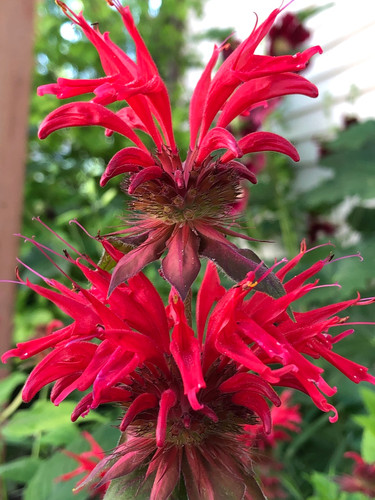One of my favorite times of summer coincides with the blooming of one of my favorite flowers, Monarda didyma, or more commonly called Bergamot or Bee Balm. This is such an unusual, striking flower and I am awed by it every summer, in fact as I am looking at this flower on my desk right now I feel emotional and wondering what is it about this flower that speaks to me.
The flower is on a stem about 3-4 feet tall and the first blossoms are usually double headers (two blooms on top of each other). Subsequent blooms after deadheading those are usually single flowers. The flowers are spiky and of a beautiful bright shade of red. The Monarda Fistulosa is a lavender version of this flower and while beautiful and a lovely scent, it usually starts blooming a good 2-3 weeks after the Red variety of Monarda and is always a single flower with soft leaves.
This flower has a long history of folk use from crushing the leaves to soothe bee stings (hence name Bee Balm) to use by the Native peoples of America to make Oswego tea as a gentle calming tea for the nervous system and to soothe indigestion. The leaves have also been used historically as a compress for sore eyes, headaches, muscle spasms,fungal infections and to slow bleeding. In battlefields, soldiers would chew on the leaves to use them on their wounds or sore muscles.
Medicinally, Monarda is an important and versatile plant for your medicine chest. It is soothing on the digestive tract and helps prevent indigestion, bloating and nausea. It is antispasmodic and is useful in treating menstrual cramps and coughs. It is a nervine that is gentle in it's action, having a calming effect on the nervous system and used to treat anxiety and stress. It has a high thymol content making it a strong antiseptic so often used in upper respiratory teas, and as a tea mouthwash for relief from sore throats, toothaches and mouth sores. It can be used externally to treat scrapes, stings and rashes (mash up some leaves) and can use the leaves in a bath for achy muscles or as a foot soak. It will also freshen breathe when drink as a tea, fight infections in the mouth and gums and relieve diarrhea, vomiting and Candida overgrowth. Very versatile indeed! To add to that impressive list, it makes a great spice for your food and can replace oregano and thyme in your recipes. Please remember to use caution by not using this plant if you are pregnant since it is an emmenogogue which stimulates blood flow.
So why am I so moved by this flower? Well, according to someone's wisdom, the flower symbolizes compassion and sympathy. Interestingly, I can see that, no I can feel that about this flower. I don't always "feel" or "tune" into flowers and plants as some claim but today, I am with this flower. Perhaps it reminds me a little of me or as I am becoming me and letting go of the shackles of society and emotional training that I am not enough and need to conform to others expectations. As I am removing those shackles and restraints on myself I find I am becoming a little more bold and unique and bright. I am letting my spiky redness come out and I am liking it and having fun.
I can sense from this bold, flashy and unique flower that it is calling me to pay attention to it, to come nearer so that it can show me myself with compassion. I struggle to be kind to myself, and I don't think I am alone in that struggle. And as I bend down to smell and observe this flower, the scent just settles me right down and I want to sit in a whole field of these bright red and lavender flowers, spread out my arms, smile, sniff and sing. I'd probably get a few bee stings doing that, as they love this flower, as do the butterflies and hummingbirds. They bring so much beauty to my garden and invite more beautiful things into my little world as well.
If you want to grow this flower, you can. It is natural to this area and thrives for me. Just be careful in where you plan to plant it as it is a spreader, as are all plants from the mint family. The gardening experts tell you it loves to grow in rich, moist and acidic soils, but I am here to tell you it does fantastic in my heavy clay, alkaline soil. Course I amend the soil with compost so not so heavy. This plant does well in full sun to part shade, grows to 3-5 feet tall and blooms in late July to September, if you keep deadheading the blooms. Give this plant plenty of space for air circulation, as it is susceptible to powdery mildew, and don't water this plant in late afternoon or evenings or that mildew really spreads. I got all my plants as starts from my friends who were thinning out their gardens, so cannot speak to the ease of starting from seed, but it is native here so I am sure it will do just fine, but what a way to find and make a friend - share a plant. You're gonna love this flower. Do you have memories growing or using this plant? Share with me, I would love to hear.
I will be featuring Monarda in some tea blends this fall and winter to support the respiratory system. If harvesting this plant for teas, like Oswego tea, use the full bloomed flower; for other teas I use the leaves and flowers just before or as fully blooming.









Comments